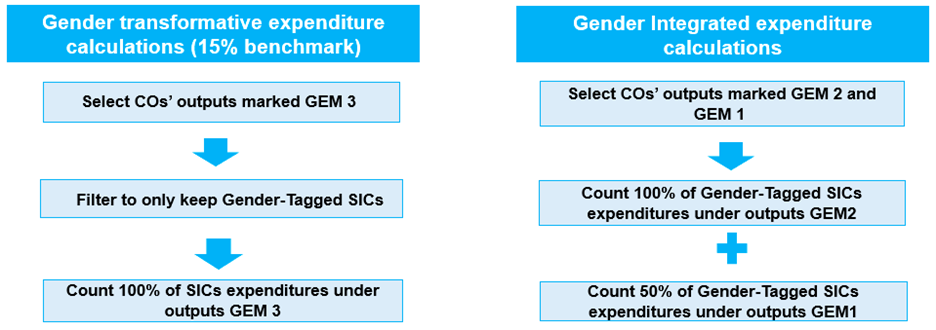Explanation on how to apply the GEM.
Module 4 explains how to apply the Gender Equality Marker. It outlines the importance of developing guidance on the GEM’s application as well as the challenges that arise when assigning the GEM scores. It also offers some tips for tagging administrative costs and presents UNICEF’s methodology for estimating financial expenditure on gender equality.
4.1 How to Code
The gender marker coding process is essential for i) tracking institutional commitments and financial resources allocated and spent on gender equality and gender-related programming; and ii) improving the gender-responsiveness of programming through iteration and internal dialogue within each UN entity.
The coding methodology of the gender equality marker should be simple, straightforward, and applicable to different types of projects / programmes with varying degrees of complexity. Gender marker codes must be determined on the overall intentions of the programme/project as stated in the project documentation; and should not be made on any implicit or assumed outcomes. A key principle that has emerged from the experiences of the early adopters of the gender equality marker, is to “code what you see”.
To translate the gender equality marker’s four-point scale and to operationalize the common coding definitions within each institutional context, UN entities as well as pooled funds have developed and updated step-by-step guidance on how to implement a coding system and process. Templates and tools such as tip sheets, checklists, and decision trees have also been designed to support greater accuracy and consistency in the coding process. Entities have also issued supplementary guidance on conducting gender analyses.
Some UN entities require or recommend that a gender analysis be carried out at the project design stage and be used to inform gender marker coding decisions (i.e., PBF, UNDP, UNFPA, UNIDO). A gender analysis – which is an essential starting point for gender mainstreaming in development interventions - can be particularly valuable to entities that apply the code at a higher level of aggregation, such as the output or project level. Whether conducted separately or as part of broader socio-economic or contextual analyses, a gender analysis is an important vehicle for systematically integrating gender equality considerations in the design and planning of interventions, including in the results, monitoring and evaluation, and budget frameworks.
Other entities have developed a set of minimum criteria that must be met in full for a project to achieve a certain gender equality marker code (COVID-19 MPTF, PBF, UNIDO). These criteria clarify the difference between the gender equality marker codes in terms of how gender equality and the empowerment of women/girls is addressed across various elements of a project framework: analysis, the objective(s), outcomes and theory of change; implementation activities, target population; the budget, risk analysis and results framework.
Source: UNIDO’s Gender Compliance and Marker Form
In addition to meeting qualitative criteria, some entities and multi-partner pooled funds use the percent of the budget allocation made to gender-equality related activities under the project or output to determine the value of the gender equality marker (PBF, UNICEF, DPPA). This coding method is used by entities who apply the gender equality marker code at a more aggregated level. (See Module 3, Section 3.5)
4.2 Addressing Coding Ambiguities
Even with clear and specific guidance, coding ambiguities will invariably arise when applying the gender equality marker in practice. Common coding challenges occur in the assignment of GEM 1 (limited contribution to gender equality) vs GEM 2/2A (gender equality as a significant objective) or GEM 2/2A gender equality as a significant objective) and GEM 3/2B (gender equality as a principal objective) scores. What should guide the coding process is an assessment of the ambition and the quality of the intended gender equality-related intervention.
GEM 1 vs GEM 2/2A
Tensions between these two scores may arise when coding large projects / outputs where only a few components or activities focus on gender equality (i.e., in infrastructure, agriculture projects/outputs)
To help reduce these coding tensions, some of the following issues should be considered:
Additional pointers:
- A project / output that ensures that women and men will benefit or participate equally is insufficient to be marked as a GEM 2/2A (or even GEM 3/2B). All projects should ensure that women and men benefit and participate equally from development interventions. This should be a default expectation. For instance, a project aimed at reforming a country's constitutional law would benefit all citizens, encompassing both women and men. However, if the project doesn't specifically introduce measures to address gender inequalities, then the appropriate coding for the gender equality marker would be GEM 1.
- Generic references to women and girls in the project description (i.e., through language such as “including women and girls”) does not necessarily merit a GEM 2/2A scoring. Intentions to address gender equality and the empowerment of women need to be reflected in the rationale, strategies, results and budget framework of a project/output/activity.
- Taking into account the context in which a project/output/activity will be implemented with respect to the situation of women and girls in a given country might be warranted. For example, an output/activity implemented in Afghanistan which ensures women’s participation might warrant a GEM 2A score, given the prohibitive restrictions on women’s and girls’ social, economic and political/public participation, whereas in a more open context, such a project/output would be scored as a GEM 1.
GEM 2/2A vs GEM 3/2B
Coding decisions on assigning a value of 2A or 2B should be determined by asking what the overarching goal of the project / output/ activity is. Both gender equality marker scores have equal merit.
Additional Pointers:
- Project / outputs should be coded as GEM 2B only if they involve programming around gender norm change or programming that directly aims to empower women and girls.
- Projects / outputs that target men and boys can be scored as GEM 2B if their engagement contributes to transforming unequal power relations and challenging gender stereotypes, discriminatory norms, attitudes and behaviours.
- Projects / outputs that target women and girls are insufficient on their own to warrant a GEM 2A or GEM 2B code. The project / output should include activities that address women’s specific needs or constraints (2A) or make a a clear contribution to reducing gender inequalities, advancing women’s priorities, and/or empowering women and girls (2B).
4.3 Using the GEM to Enhance Gender Equality in Project Planning: Insights from UNICEF and UNFPA
Because the gender equality marker is applied at the planning stage, project managers can strengthen the gender equality considerations of their initiatives; to improve their gender equality marker scores as well as to enhance both resources and impact for gender equality and the empowerment of women and girls. Below are two examples, one drawn from UNICEF, the other from UNFPA that demonstrate this.
UNICEF Example: Child Nutrition
For more info please check UNICEF's good practice on applying the GEM.
UNFPA Example: Educating young people on Sexual and Reproductive Health issues
For more info please check UNFPA's good practice on applying the GEM.
4.4 How to Code: Operational/Administrative Costs
Coding operational budgets where there is no indication of gender equality content presents a challenge for many UN entities and there is limited guidance on how operating costs should be coded. Operating or management costs are defined as those costs which ‘comprise activities and associated costs whose primary function of is to promote the identity, direction and well-being of the organization. These include executive direction, representation, external relations and partnerships, corporate communications, legal affairs, oversight, audit, corporate evaluation, information technology, finance, administration, security and human resources.’
Each entity will need to develop a clear policy and guidelines on applying the gender equality marker to these costs.
Most entities apply their gender equality marker to their programmatic budgets. The practice in some entities, like UNFPA and ESCWA, has been to code administrative or operating activities by assessing the programmatic activity/output it supports and the contribution of that activity to gender equality and the empowerment of women. For example, if a series of activities all contribute to the production of a report related to gender norms, then all the associated activities (research, consultations, printing) would be coded as 2b.
Coding staff costs follow a similar logic. The salary of a gender advisor is considered a 2b; whereas the salaries of other staff would depend on the degree to which they engage in gender issues. To guide the financial allocation, staff or consultant TORs are used to estimate the percentage of time that staff or consultant(s) will work on gender-related issues.
Example: UNFPA
UNFPA has developed tagging guidance to support the coding of administrative costs by leading staff through a series of questions and the provision of examples.

Source: At-a-glance Guidance for UNFPA Staff
Example: The Peacebuilding Fund
Applicant organizations to the Peacebuilding Fund (PBF) develop project results-based budgets, where in addition to providing an estimated percentage of the budget per activity, they also estimate the percentage of personnel and other operational costs that will be allocated to gender equality and the empowerment of women, supported by a justification for that allocation. Such costs are typically estimated based on the specialized gender advisor capacity that is available to ensure the integration of gender-sensitive approaches throughout the project cycle, including in the evaluation of the project or the project’s stated commitment to recruit staff or consultants, including M&E specialists, with gender expertise to support project implementation. Allocations for personnel costs are made using Terms of Reference to estimate the percentage of time a staff or consultant will work on gender equality related issues. Like UNFPA, the Peacebuilding Fund, in its guidance, provides applicants with overarching questions to aid applicants on how to estimate the proportion of these costs.
4.5 Methodologies for Estimating Financial Expenditures on Gender Equality: the Case of UNICEF
UN entities use different methodologies for estimating financial allocations and/or expenditures to gender equality and the empowerment of women. Much of this depends on the level at which they apply the gender equality marker in their ERP systems.
Tracking and aggregating indicative gender equality allocations and/or expenditures is straightforward for initiatives where gender equality is the principal objective (GEM 2B/3). Tracking and aggregating financial allocations and/or expenditures becomes easier if the entity applies the gender equality marker at the activity level, which is the recommended level, for being the level in which the budget is normally assigned.
UNICEF’s innovative methodology offers an instructive experience for calculating its gender equality expenditures. UNICEF uses its gender equality marker system, that is applied at the output level and its gender tagging system, that is applied at the activity level as the two main parameters for calculating gender equality expenditures. Gender equality expenditures are calculated on two measures
As the below figure shows,
- Gender-transformative expenditures are calculated by focusing on and adding up those Specific Intervention Codes (or activities) that are gender tagged under GEM3 (principal objectives) outputs. This enables UNICEF to track its progress against the 15% financial target. AND
- Gender integrated expenditures include outputs that have been marked as GEM 2 (significant objective) and GEM 1 (limited contribution). As above, Specific Intervention Codes (or activities) that are gender tagged under GEM2 are counted 100% towards expenditures, while Specific Intervention Codes (or activities) that are gender tagged under GEM1 are counted 50% towards expenditures.

For more information, please check the Good Practice of UNICEF.
